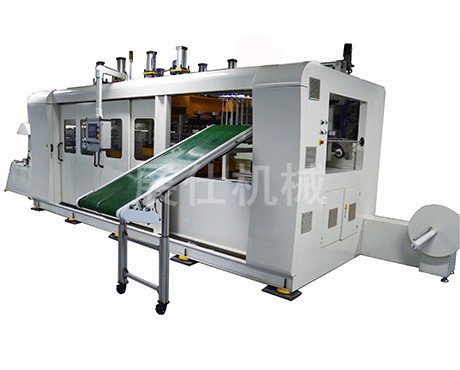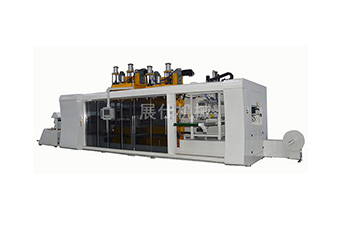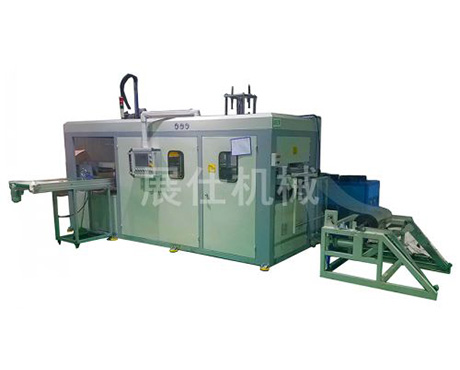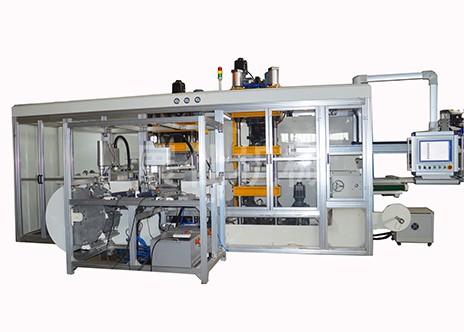Welcome to Shanghai Zhanshi Machinery Equipment Co., Ltd.!

Shanghai Zhanshi Machinery Equipment Co., Ltd.
Strength, excellence, professionalism Thick sheet blister manufacturer

phone:
021-39874815
138-17814499
News
Navigation bar


Analysis of factors in plastic forming process
Source:
|
Author:zhanshiwap
|
Published time: 2019-05-31
|
458 Views
|
Share:
There are many process factors affecting thermoforming. In short, the determination of the molding process depends on the material, the thickness of the sheet (sheet), the shape of the part, the precision of the surface of the part, the conditions of use of the part, the molding method and the molding. Comprehensive consideration of equipment structure and other aspects. .....
First, several factors affecting the thermoforming process
The main processes of thermoforming are heating, forming and cooling. Process factors to be considered in thermoforming include heating time, molding temperature, molding speed, molding pressure, cooling conditions, etc.
1, heating
Heating time is one of the main parameters of the thermoforming process. The time required to heat the sheet to the molding is referred to as the heating time, typically about 50% to 80% of the entire molding cycle. Therefore, in the molding process, how to shorten the heating time is of great significance.
The time required for heating increases as the thickness of the sheet increases. In addition, the heating time is also affected by the material and thermal conductivity. The larger the specific volume of the material, the smaller the thermal conductivity, the longer the heating time. Of course, the heating time is also related to the type of heater, the surface temperature, the distance between the heater and the sheet, and various factors of the ambient temperature, so it is rather complicated.
2, molding
Molding is another important process after the sheet is heated, including the control of important technical parameters such as molding temperature, molding speed and molding pressure.
1, molding temperature
After the material, process type and equipment are determined, the forming temperature is the main factor affecting the quality of the part, which directly affects the minimum thickness, thickness distribution and dimensional error of the part.
2, molding pressure
Only when pressure is applied can the sheet be deformed, but the plastic has the ability to resist deformation and its modulus of elasticity decreases with increasing temperature. At the molding temperature, the deformation of the material can only be caused when the stress caused by the molding pressure in the material is greater than the elastic modulus at that temperature. If the pressure applied at a certain temperature is not sufficient to cause sufficient elongation of the material, the molding pressure can be increased only by increasing the molding pressure or raising the molding temperature. Since various plastics have different elastic moduli and different dependence on temperature, the molding pressure varies depending on the type of plastic, the thickness of the sheet, and the molding temperature. In general, the molecular chain constituting the resin is large in rigidity, high in molecular weight, and there is a grade group of plastics, which requires high molding pressure.
.
3, molding speed
The molding speed refers to the drafting rate of the sheet. Increasing the molding speed can shorten the molding cycle, which is advantageous for improving productivity, but excessive molding speed will affect the product quality.
In thermoforming, the plastic sheet is stretched and deformed under the pressure or the push of the plunger, and the forming speed is different, and the stretching speed of the material is different. When the molding temperature is not high, slow molding is suitably employed, and the elongation of the material is large, which is important for large parts. However, the molding speed is slow, the material is easy to cool, the molding becomes difficult, and the molding cycle is prolonged. Therefore, for a certain thickness of the sheet, a faster forming speed should be adopted while appropriately increasing the heating temperature.
Three mold temperature
The mold temperature is also a factor that affects the quality of the product after the sheet is formed. Generally, the part that first contacts the large mold after the sheet is stretched is first cooled, and the stretch ratio is the smallest when the upper mold and the vacuum are applied, so the thickness Larger, the adjacent parts are stretched larger and the thickness is smaller. The effect of mold temperature on molding is manifested in many ways. When the mold temperature is high, the surface of the product has high gloss and clear outline, but the molding cycle is prolonged. Appropriate mold temperature can also reduce the internal stress of the product and reduce the stretch wrinkles of the product.
Four cooling demoulding
Due to the poor thermal conductivity of plastics, as the thickness of the formed sheet increases, the cooling will increase accordingly, so manual cooling must be used to shorten the cycle. As mentioned above, there are two types of cooling methods, internal cooling and external cooling. They can be used alone or in combination, depending on the needs of the product. However, it is often used because external cooling is simple and easy. Regardless of the manner in which it is cooled, it is important that the shaped article must be cooled below the deformation temperature to demold.
Except that the plastic sheet is decomposed due to excessive heating or the surface of the mold is too rough, the sheet rarely exhibits adhesion to the mold. If this happens occasionally, a mold release agent can be applied to the surface of the mold to eliminate this drawback. However, the amount should not be too much, so as not to affect the roughness and transparency of the product.
Five plastic materials
The formability of plastic materials is very important for thermoforming. Because heat transfer occurs when the material comes into contact with the mold to lower the temperature, the elastic modulus of the contact portion increases, so that further deformation is less likely to occur, and the uncontacted portion continues to be stretched and thinned, which makes the deep-size part The sidewalls become very thin and can even stretch and break.
In general, when the elongation of the plastic is temperature sensitive, it is suitable for molding with a large pressure and a slow speed, and is suitable for heating in a separate heating box and shaping in a mold. While the elongation of the plastic is not sensitive to temperature, it is suitable for use with less pressure and rapid prototyping. Such sheets are easily held on the mold and heated by a movable heater.
In summary, there are many process factors affecting thermoforming. In short, the determination of the molding process depends on the material, the thickness of the sheet (plate), the shape of the part, the accuracy of the surface of the part, and the conditions of use of the part. , the molding method and the structure of the molding equipment are considered comprehensively.
The main processes of thermoforming are heating, forming and cooling. Process factors to be considered in thermoforming include heating time, molding temperature, molding speed, molding pressure, cooling conditions, etc.
1, heating
Heating time is one of the main parameters of the thermoforming process. The time required to heat the sheet to the molding is referred to as the heating time, typically about 50% to 80% of the entire molding cycle. Therefore, in the molding process, how to shorten the heating time is of great significance.
The time required for heating increases as the thickness of the sheet increases. In addition, the heating time is also affected by the material and thermal conductivity. The larger the specific volume of the material, the smaller the thermal conductivity, the longer the heating time. Of course, the heating time is also related to the type of heater, the surface temperature, the distance between the heater and the sheet, and various factors of the ambient temperature, so it is rather complicated.
2, molding
Molding is another important process after the sheet is heated, including the control of important technical parameters such as molding temperature, molding speed and molding pressure.
1, molding temperature
After the material, process type and equipment are determined, the forming temperature is the main factor affecting the quality of the part, which directly affects the minimum thickness, thickness distribution and dimensional error of the part.
2, molding pressure
Only when pressure is applied can the sheet be deformed, but the plastic has the ability to resist deformation and its modulus of elasticity decreases with increasing temperature. At the molding temperature, the deformation of the material can only be caused when the stress caused by the molding pressure in the material is greater than the elastic modulus at that temperature. If the pressure applied at a certain temperature is not sufficient to cause sufficient elongation of the material, the molding pressure can be increased only by increasing the molding pressure or raising the molding temperature. Since various plastics have different elastic moduli and different dependence on temperature, the molding pressure varies depending on the type of plastic, the thickness of the sheet, and the molding temperature. In general, the molecular chain constituting the resin is large in rigidity, high in molecular weight, and there is a grade group of plastics, which requires high molding pressure.
.
3, molding speed
The molding speed refers to the drafting rate of the sheet. Increasing the molding speed can shorten the molding cycle, which is advantageous for improving productivity, but excessive molding speed will affect the product quality.
In thermoforming, the plastic sheet is stretched and deformed under the pressure or the push of the plunger, and the forming speed is different, and the stretching speed of the material is different. When the molding temperature is not high, slow molding is suitably employed, and the elongation of the material is large, which is important for large parts. However, the molding speed is slow, the material is easy to cool, the molding becomes difficult, and the molding cycle is prolonged. Therefore, for a certain thickness of the sheet, a faster forming speed should be adopted while appropriately increasing the heating temperature.
Three mold temperature
The mold temperature is also a factor that affects the quality of the product after the sheet is formed. Generally, the part that first contacts the large mold after the sheet is stretched is first cooled, and the stretch ratio is the smallest when the upper mold and the vacuum are applied, so the thickness Larger, the adjacent parts are stretched larger and the thickness is smaller. The effect of mold temperature on molding is manifested in many ways. When the mold temperature is high, the surface of the product has high gloss and clear outline, but the molding cycle is prolonged. Appropriate mold temperature can also reduce the internal stress of the product and reduce the stretch wrinkles of the product.
Four cooling demoulding
Due to the poor thermal conductivity of plastics, as the thickness of the formed sheet increases, the cooling will increase accordingly, so manual cooling must be used to shorten the cycle. As mentioned above, there are two types of cooling methods, internal cooling and external cooling. They can be used alone or in combination, depending on the needs of the product. However, it is often used because external cooling is simple and easy. Regardless of the manner in which it is cooled, it is important that the shaped article must be cooled below the deformation temperature to demold.
Except that the plastic sheet is decomposed due to excessive heating or the surface of the mold is too rough, the sheet rarely exhibits adhesion to the mold. If this happens occasionally, a mold release agent can be applied to the surface of the mold to eliminate this drawback. However, the amount should not be too much, so as not to affect the roughness and transparency of the product.
Five plastic materials
The formability of plastic materials is very important for thermoforming. Because heat transfer occurs when the material comes into contact with the mold to lower the temperature, the elastic modulus of the contact portion increases, so that further deformation is less likely to occur, and the uncontacted portion continues to be stretched and thinned, which makes the deep-size part The sidewalls become very thin and can even stretch and break.
In general, when the elongation of the plastic is temperature sensitive, it is suitable for molding with a large pressure and a slow speed, and is suitable for heating in a separate heating box and shaping in a mold. While the elongation of the plastic is not sensitive to temperature, it is suitable for use with less pressure and rapid prototyping. Such sheets are easily held on the mold and heated by a movable heater.
In summary, there are many process factors affecting thermoforming. In short, the determination of the molding process depends on the material, the thickness of the sheet (plate), the shape of the part, the accuracy of the surface of the part, and the conditions of use of the part. , the molding method and the structure of the molding equipment are considered comprehensively.
Recommended products


support hotline:021-39874815
Fax:021-39874160
E-mail:anna@shzhanshi.com
Add:No. 26, Kangyuan Road, Zhujiajiao Industrial Park, Qingpu District, Shanghai
Contact information
shanghai zhanshi

all rights reserved © Shanghai Zhanshi Machinery Equipment Co., Ltd. 沪ICP备19041957号-1
QQ:3065496668 phone:021-39874815 Technical Support:shuangyingw
Add:No. 26, Kangyuan Road, Zhujiajiao Industrial Park, Qingpu District, Shanghai
(Hongqiao Subway Line 17)
Shanghai Public Network Security Equipment 31011702004465












